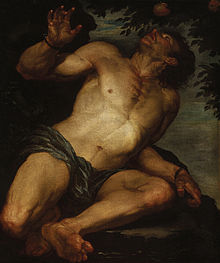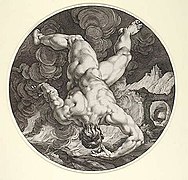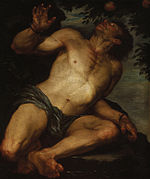Tantalus
| Tantalus | |
|---|---|
Mythological King | |
 Tantalus by Gioacchino Assereto | |
| Other names | Atys |
| Abode | Lydia or Phrygia or Paphlagonia |
| Genealogy | |
| Parents | (1) Zeus and Pluto (2) Tmolus and Pluto |
| Consort | (i) Dione (ii) Taygete (iii) Eurythemista (iv) Euryanassa (v) Clytie (vi) Eupryto |
| Children | Pelops, Niobe, Broteas and Dascylus |
| Part of a series on the |
| Greek underworld |
|---|
| Residents |
| Geography |
| Prisoners |
| Visitors |
Tantalus (Ancient Greek: Τάνταλος Tántalos), also called Atys, was a Greek mythological figure, most famous for his punishment in Tartarus: for revealing many secrets of the gods and for trying to trick them into eating his son, he was made to stand in a pool of water beneath a fruit tree with low branches, with the fruit ever eluding his grasp, and the water always receding before he could take a drink.
Tantalus was the father of Pelops, Niobe, and Broteas. He was a son of Zeus[1] or Tmolus[2] and a woman named Pluto. Thus, like other heroes in Greek mythology such as Theseus (his great-great-grandson) and the Dioskouroi, he had one divine and one mortal parent.
The Greeks used the proverb "Tantalean punishment" (Ancient Greek: Ταντάλειοι τιμωρίαι: Tantáleioi timōríai) in reference to those who have good things but are not permitted to enjoy them.[3] His name and punishment are also the source of the English word tantalize, meaning to torment with the sight of something desired but out of reach; tease by arousing expectations that are repeatedly disappointed.[4]
Etymology
[edit]Plato in the Cratylus (395e) interprets Τάνταλος (Tántalos) as ταλάντατος (talántatos) [acc. ταλάντατον: talántaton in the original], "who has to bear much" from τάλας (tálas) "wretched".
The word τάλας (tálas) is held by some to be inherited from Proto-Indo-European, although R. S. P. Beekes rejects an Indo-European interpretation.[5]
Historical background
[edit]
There may have been a historical Tantalus, possibly the ruler of an Anatolian city named "Tantalís",[6] "the city of Tantalus", or of a city named "Sipylus".[7] Pausanias reports that there was a port under his name and a sepulcher of him "by no means obscure", in the same region.
Tantalus is sometimes referred to as "King of Phrygia",[8] although his city was located in the western extremity of Anatolia, where Lydia was to emerge as a state before the beginning of the first millennium BC, and not in the traditional heartland of Phrygia, situated more inland. References to his son as "Pelops the Lydian" led some scholars to the conclusion that there would be good grounds for believing that he belonged to a primordial house of Lydia.[9][10][11]
Other versions name his father as Tmolus, the name of a king of Lydia and, like Sipylus, of another mountain in ancient Lydia. The location of Tantalus' mortal mountain-fathers generally placed him in Lydia;[12] and more seldom in Phrygia[9] or Paphlagonia,[10] all in Asia Minor.
The identity of his wife is variously given: generally as Dione the daughter of Atlas;[13] the Pleiad Taygete, daughter of Atlas; Eurythemista, a daughter of the river-god Xanthus;[14] Euryanassa, daughter of Pactolus, another river-god of Anatolia, like the Xanthus;[14][15] Clytia, the child of Amphidamantes;[14][16] and Eupryto.[17] Tantalus was also called the father of Dascylus.[18]
Tantalus, through Pelops, was the progenitor of the House of Atreus, which was named after his grandson Atreus. Tantalus was also the great-grandfather of Agamemnon and Menelaus.
The geographer Strabo states that the wealth of Tantalus was derived from the mines of Phrygia and Mount Sipylus. Near Mount Sipylus are archaeological features that have been associated with Tantalus and his house since Antiquity. Near Mount Yamanlar in İzmir (ancient Smyrna), where the Lake Karagöl (Lake Tantalus) associated with the accounts surrounding him is found, is a monument mentioned by Pausanias: the tholos "tomb of Tantalus" (later Christianized as "Saint Charalambos' tomb") and another one in Mount Sipylus,[19] and where a "throne of Pelops", an altar or bench carved in rock and conjecturally associated with his son is found.
Based on a similarity between the names Tantalus and Hantili, it has been suggested that the name Tantalus may have derived from that of these two Hittite kings.[20]
| Relation and Name | Sources | ||||||||||||||||||||||||
|---|---|---|---|---|---|---|---|---|---|---|---|---|---|---|---|---|---|---|---|---|---|---|---|---|---|
| Pin. | (Sch.) Eur. | Aris. | Iso. | Sch. Ap. Rh. | Lyc. | Dio. Sic. | Hor. | Par. | Ov. | Str. | Stat. | Apd. | Tac. | Plut. | Hyg. | Pau. | Clem. | Anti. | Non. | Ser. | Gk. Ant. | Tzet. | W.S. | R.G. | |
| Parentage | |||||||||||||||||||||||||
| Tmolus and Pluto | ✔️ | ✔️ | |||||||||||||||||||||||
| Zeus | ✔️ | ✔️ | ✔️ | ✔️ | |||||||||||||||||||||
| Zeus and Pluto | ✔️ | ✔️ | ✔️ | ✔️ | ✔️ | ||||||||||||||||||||
| Spouse | |||||||||||||||||||||||||
| Euryanassa | ✔️ | ✔️ | ✔️ | ||||||||||||||||||||||
| Dione | ✔️[21] | ✔️ | ✔️ | ||||||||||||||||||||||
| Eupryto | ✔️ | ||||||||||||||||||||||||
| Eurythemista | ✔️ | ||||||||||||||||||||||||
| Children | |||||||||||||||||||||||||
| Pelops | ✔️[22] | ✔️ | ✔️ | ✔️ | ✔️[22] | ✔️ | ✔️ | ✔️ | ✔️ | ✔️ | ✔️ | ✔️ | ✔️ | ✔️ | ✔️ | ||||||||||
| Niobe | ✔️[23] | ✔️ | ✔️ | ✔️ | ✔️ | ✔️[23] | ✔️ | ✔️ | ✔️ | ✔️ | ✔️ | ||||||||||||||
| Dascylus | ✔️ | ||||||||||||||||||||||||
| Broteas | ✔️ | ||||||||||||||||||||||||
Mythology
[edit]

Tantalus became one of the inhabitants of Tartarus, the deepest portion of the Underworld, reserved for the punishment of evildoers; there Odysseus saw him.[25] The association of Tantalus with the underworld is underscored by the names of his mother Pluto ("riches", as in gold and other mineral wealth), and grandmother, Chthonia ("earth").
Tantalus was initially known for having been welcomed to Zeus' table in Olympus, like Ixion. There, he is said to have abused Zeus' hospitality and stolen ambrosia and nectar to bring it back to his people, and revealed the secrets of the gods.[26]
Most famously, Tantalus offered up his son, Pelops, as a sacrifice. He cut Pelops up, boiled him, and served him up in a banquet for several gods in order to test their omniscience. The gods became aware of the gruesome nature of the menu, so they did not touch the offering; only Demeter, distraught by the loss of her daughter, Persephone, absentmindedly ate part of the boy's shoulder.
Clotho, one of the three Fates, was ordered by Zeus to bring the boy to life again. She collected the parts of the body and boiled them in a sacred cauldron, rebuilding his shoulder with one wrought of ivory made by Hephaestus and presented by Demeter.
The revived Pelops grew to be an extraordinarily handsome youth. The god Poseidon took him to Mount Olympus to teach him to use chariots. Later, Zeus threw Pelops out of Olympus due to his anger at Tantalus.
Tantalus's punishment for his act was to stand in a pool of water beneath a fruit tree with low branches. Whenever he reached for the fruit, the branches raised his intended meal from his grasp. Whenever he bent down to get a drink, the water receded before he could get any.
Over his head towers a threatening stone (mentioned in Pindar's 8th Isthmian ode, lines 10–12) like the one that Sisyphus is punished to roll up a hill.[27] This fate has cursed him with eternal deprivation of nourishment.
In a different story, Tantalus was blamed for indirectly having stolen the gold dog which Rhea had once put to watch over infant Zeus (in another version, it was a mechanical dog crafted by Hephaestus to guard a temple of Zeus[28]). Tantalus's friend Pandareus stole the dog and gave it to Tantalus for safekeeping. When asked later by Pandareus to return the dog, Tantalus denied that he had it, saying he "had neither seen nor heard of a golden dog." According to Robert Graves in The Greek Myths, this incident is why an enormous stone hangs over Tantalus's head.[29] Others state that it was Tantalus who stole the dog, and gave it to Pandareus for safekeeping.
Tantalus was also the founder of the cursed House of Atreus in which variations on these atrocities continued. Misfortunes also occurred as a result of these acts, making the house the subject of many Greek tragedies. Tantalus's grave-sanctuary stood on Sipylus[30] but honours were paid him at Argos, where local tradition claimed to possess his bones.[31] In Lesbos, there was another hero-shrine in the small settlement of Polion and a mountain named after Tantalos.[32]
Tantalus in art
[edit]-
Engraving by Hendrik Goltzius and C. Cornelius (1588)
-
Oil painting by Gioacchino Assereto (circa 1640s)
-
Etching by Francisco Goya (1797)
See also
[edit]- Child cannibalism
- Lycaon (king of Arcadia)
- Prometheus
- Sisyphus
- Xenia, the Greek concept of hospitality, which Tantalus is described as breaking
References
[edit]- ^ Euripides, Orestes
- ^ "Tantalus". Encyclopedia Britannica.
- ^ Suida, s.v. tau.78
- ^ "Tantalize - Define Tantalize at Dictionary.com". dictionary.com. Retrieved 5 January 2023.
- ^ R. S. P. Beekes, Etymological Dictionary of Greek, Brill, 2009, p. 1449.
- ^ George Perrot (2007). History of Art in Phrygia, Lydia, Caria And Lycia (in French and English). Marton Press. p. 62. ISBN 978-1-4067-0883-7.
- ^ This refers to Mount Sipylus, at the foot of which his city was located and whose ruins were reported to be still visible in the beginning of the Common Era, although few traces remain today. See Sir James Frazer, Pausanias, and other Greek sketches (later retitled Pausanias's Description of Greece).
- ^ Thomas Bulfinch (June 2004). Bulfinch's Mythology. Kessinger Publishing Company. pp. 1855–2004. ISBN 1-4191-1109-4.
- ^ a b Strabo, 12.8.21
- ^ a b Diodorus Siculus, 4.74
- ^ Gantz, Timothy (1993). Early Greek myth : a guide to literary and artistic sources. Baltimore: Johns Hopkins University Press. p. 536. ISBN 0-8018-4410-X. OCLC 26304278.
- ^ Pindar, Olympian Odes 1.24–38, 9.9; Strabo, 1.3.17; Pausanias, 5.1.6 & 9.5.7
- ^ Ovid, Metamorphoses 6.174; Hyginus, Fabulae 82 & 83
- ^ a b c Robert Graves. The Greek Myths, section 108 (1960)
- ^ Scholia ad Euripides, Orestes 5; Tzetzes on Lycophron, 52
- ^ Scholia ad Euripides, Orestes 11
- ^ Apostol. Cent. 18.7
- ^ Scholia on Apollonius Rhodius, Argonautica 2.752
- ^ Various sites called the "tomb of Tantalus" have been shown to travellers since the time of Pausanias.
- ^ M. L. West (1999). The East Face of Helicon: West Asiatic Elements in Greek Poetry and Myth. Oxford University Press. p. 475. ISBN 978-0-19-815221-7.
- ^ This certainly pertains to her as the daughter of Atlas and thus, the sister of the Pleiades. Compare Hyginus, Fabulae 82 & 83; Ovid. Metamorphoses 6.174
- ^ a b Not named but certainly points out to him
- ^ a b Not named but certainly describes her
- ^ "De val van Tantalus". lib.ugent.be. Retrieved 2 October 2020.
- ^ Homer, Odyssey 11.582–92; Tantalus' transgressions are not mentioned; they must already have been well known to Homer's late-8th-century hearers.
- ^ Euripides, Orestes 10; Pindar, Olympian Odes 1.60 ff.
- ^ This detail was added to the myth by the painter Polygnotus, according to Pausanias (10.31.12), noted in Kerenyi 1959:61.
- ^ Eustathius of Thessalonica, On Homer's Odyssey 19.710
- ^ Graves, Robert (2012). The Greek Myths. London: Penguin. ISBN 9780143106715.
- ^ Pausanias, 2.22.3
- ^ Pausanias, 2.22.2
- ^ Stephen of Byzantium, noted by Kerenyi 1959:57, note 218.
Bibliography
[edit]- Apollodorus, The Library with an English Translation by Sir James George Frazer, F.B.A., F.R.S. in 2 Volumes, Cambridge, MA, Harvard University Press; London, William Heinemann Ltd. 1921. ISBN 0-674-99135-4. Online version at the Perseus Digital Library. Greek text available from the same website.
- Chisholm, Hugh, ed. (1911). . Encyclopædia Britannica. Vol. 26 (11th ed.). Cambridge University Press. p. 401.
- Diodorus Siculus, The Library of History translated by Charles Henry Oldfather. Twelve volumes. Loeb Classical Library. Cambridge, Massachusetts: Harvard University Press; London: William Heinemann, Ltd. 1989. Vol. 3. Books 4.59–8. Online version at Bill Thayer's Web Site
- Diodorus Siculus, Bibliotheca Historica. Vol 1–2. Immanel Bekker. Ludwig Dindorf. Friedrich Vogel. in aedibus B. G. Teubneri. Leipzig. 1888–1890. Greek text available at the Perseus Digital Library.
- Euripides, The Complete Greek Drama, edited by Whitney J. Oates and Eugene O'Neill Jr. in two volumes. 2. Orestes, translated by Robert Potter. New York. Random House. 1938. Online version at the Perseus Digital Library.
- Euripides, Euripidis Fabulae. vol. 3. Gilbert Murray. Oxford. Clarendon Press, Oxford. 1913. Greek text available at the Perseus Digital Library.
- Gaius Julius Hyginus, Fabulae from The Myths of Hyginus translated and edited by Mary Grant. University of Kansas Publications in Humanistic Studies. Online version at the Topos Text Project.
- Gantz, Timothy (1993). Early Greek Myth. Baltimore: Johns Hopkins University Press.
- Graves, Robert (2012). The Greek Myths. London: Penguin. ISBN 9780143106715.
- Grimal, Pierre, The Dictionary of Classical Mythology, Wiley-Blackwell, 1996, ISBN 978-0-631-20102-1. "Tantalus" p. 431
- Homer, The Odyssey with an English Translation by A.T. Murray, Ph.D. in two volumes. Cambridge, MA., Harvard University Press; London, William Heinemann, Ltd. 1919. ISBN 978-0674995611. Online version at the Perseus Digital Library. Greek text available from the same website.
- Hyginus, Fabulae from The Myths of Hyginus translated and edited by Mary Grant. University of Kansas Publications in Humanistic Studies. Online version at the Topos Text Project.
- Kerenyi, Karl (1959). The Heroes of the Greeks. New York/London: Thames and Hudson.pp 57–61 et passim
- Pausanias, Description of Greece with an English Translation by W.H.S. Jones, Litt.D., and H.A. Ormerod, M.A., in 4 Volumes. Cambridge, MA, Harvard University Press; London, William Heinemann Ltd. 1918. ISBN 0-674-99328-4. Online version at the Perseus Digital Library
- Pausanias, Graeciae Descriptio. 3 vols. Leipzig, Teubner. 1903. Greek text available at the Perseus Digital Library.
- Pindar, Odes translated by Diane Arnson Svarlien. 1990. Online version at the Perseus Digital Library.
- Pindar, The Odes of Pindar including the Principal Fragments with an Introduction and an English Translation by Sir John Sandys, Litt.D., FBA. Cambridge, MA., Harvard University Press; London, William Heinemann Ltd. 1937. Greek text available at the Perseus Digital Library.
- Publius Ovidius Naso, Metamorphoses translated by Brookes More (1859–1942). Boston, Cornhill Publishing Co. 1922. Online version at the Perseus Digital Library.
- Publius Ovidius Naso, Metamorphoses. Hugo Magnus. Gotha (Germany). Friedr. Andr. Perthes. 1892. Latin text available at the Perseus Digital Library.
 Smith, William, ed. (1848). "Ta'ntalus". Dictionary of Greek and Roman Biography and Mythology.
Smith, William, ed. (1848). "Ta'ntalus". Dictionary of Greek and Roman Biography and Mythology.- Strabo, The Geography of Strabo. Edition by H.L. Jones. Cambridge, Mass.: Harvard University Press; London: William Heinemann, Ltd. 1924. Online version at the Perseus Digital Library.
- Strabo, Geographica edited by A. Meineke. Leipzig: Teubner. 1877. Greek text available at the Perseus Digital Library.
- Suida, Suda Encyclopedia translated by Ross Scaife, David Whitehead, William Hutton, Catharine Roth, Jennifer Benedict, Gregory Hays, Malcolm Heath Sean M. Redmond, Nicholas Fincher, Patrick Rourke, Elizabeth Vandiver, Raphael Finkel, Frederick Williams, Carl Widstrand, Robert Dyer, Joseph L. Rife, Oliver Phillips and many others. Online version at the Topos Text Project.
External links
[edit]- The Warburg Institute Iconographic Database (images of Tantalus)
 Media related to Tantalus at Wikimedia Commons
Media related to Tantalus at Wikimedia Commons



